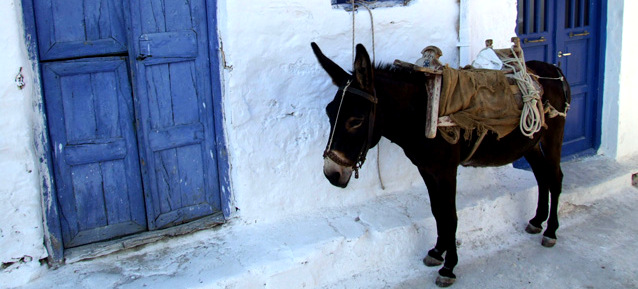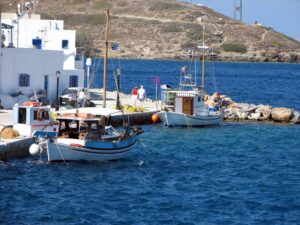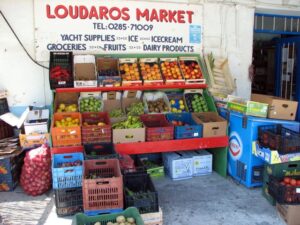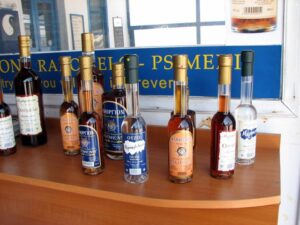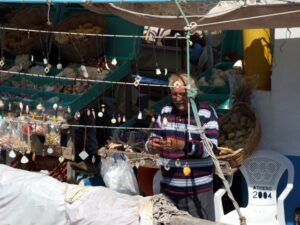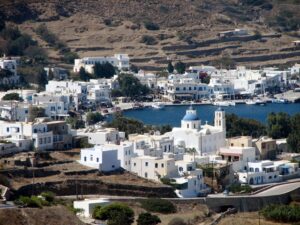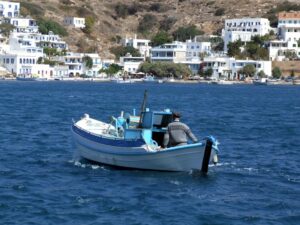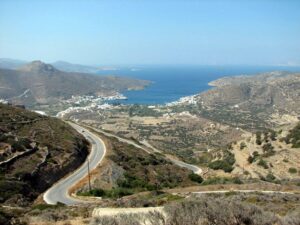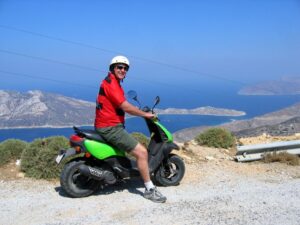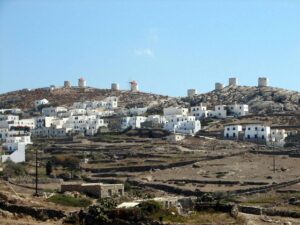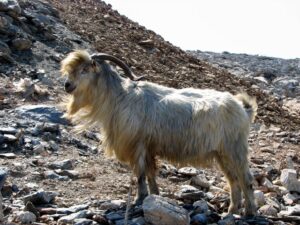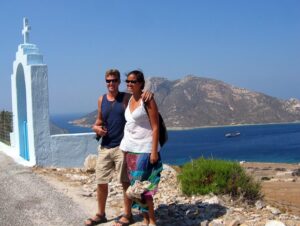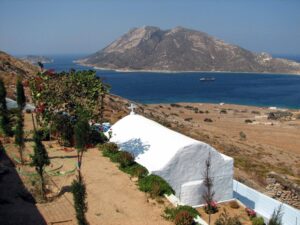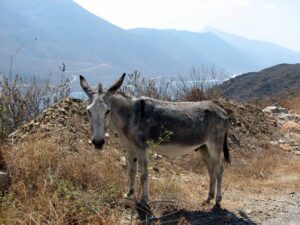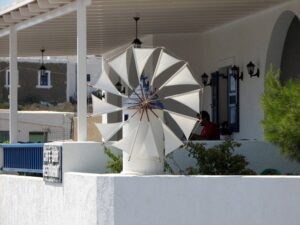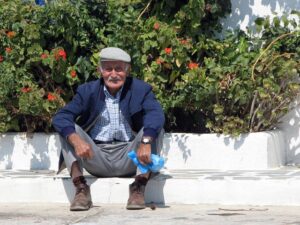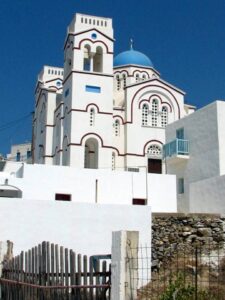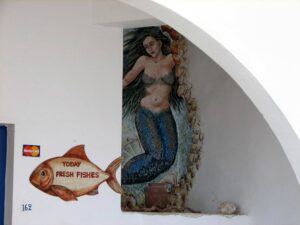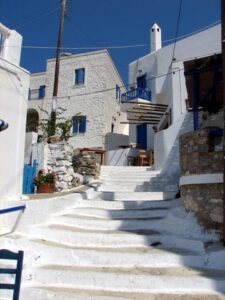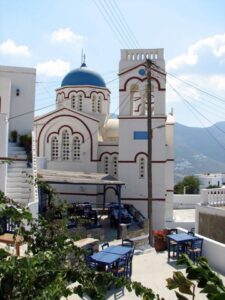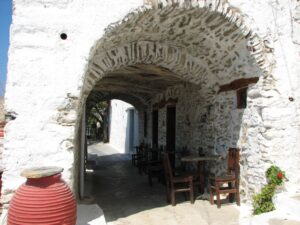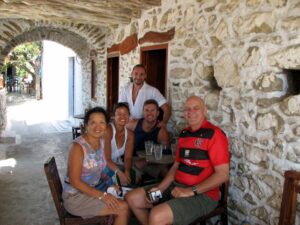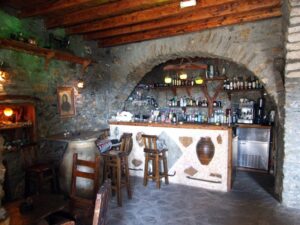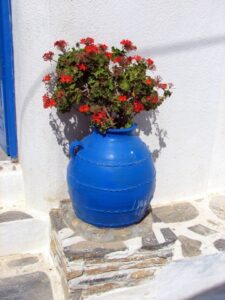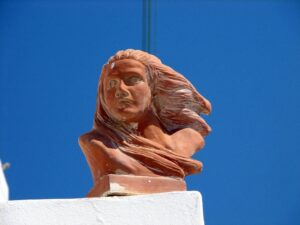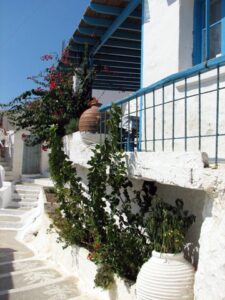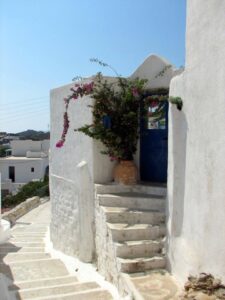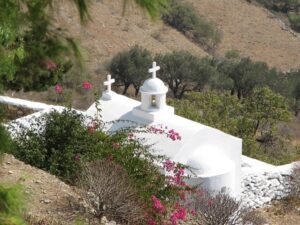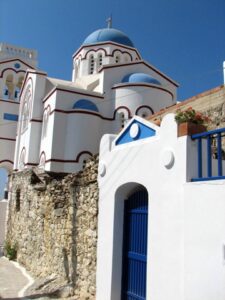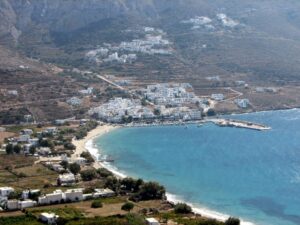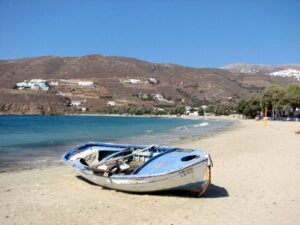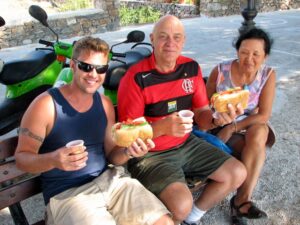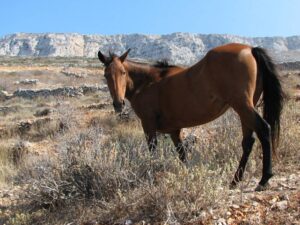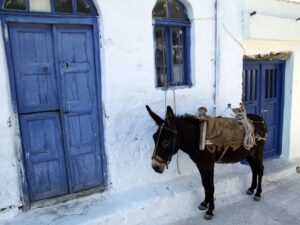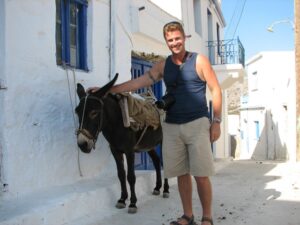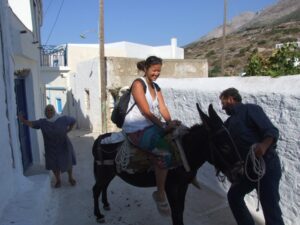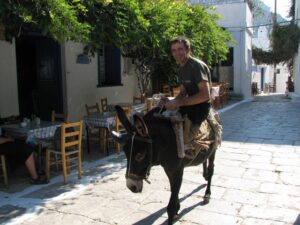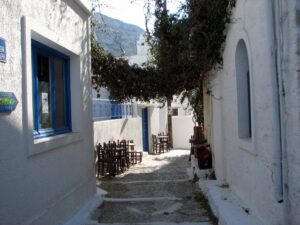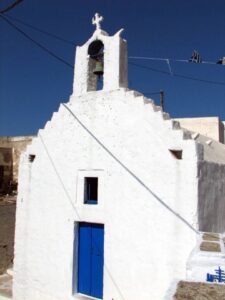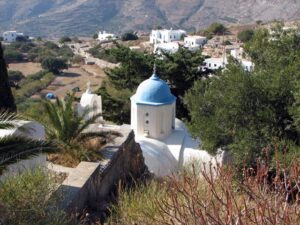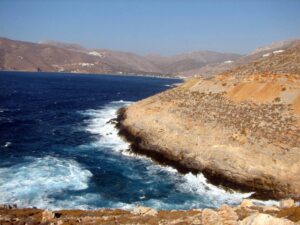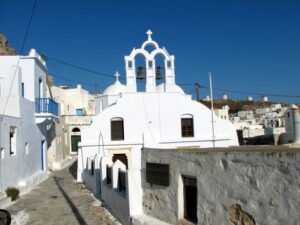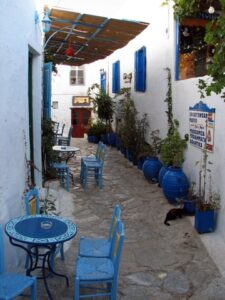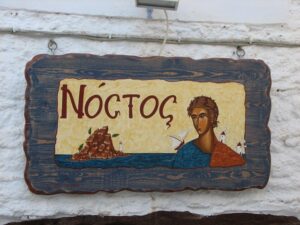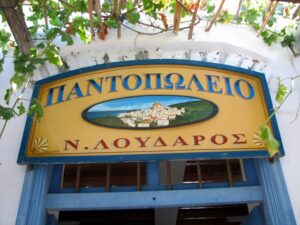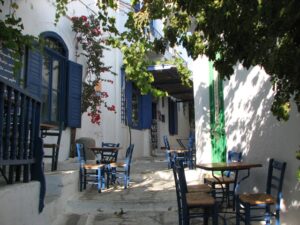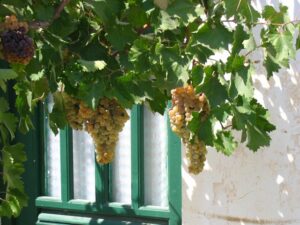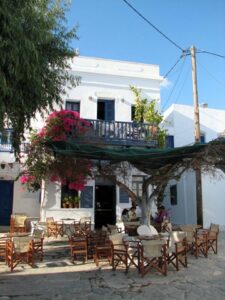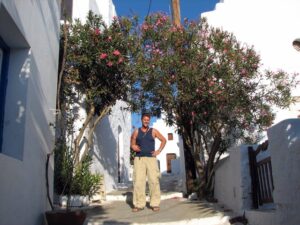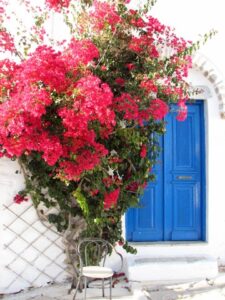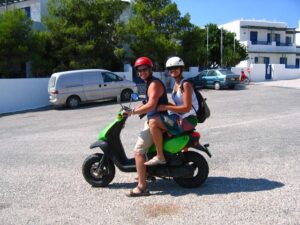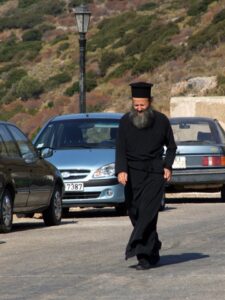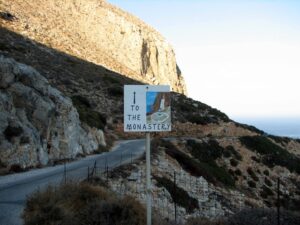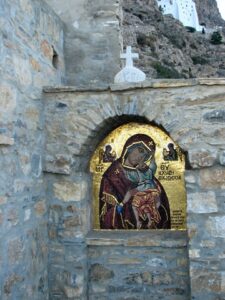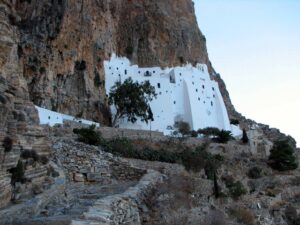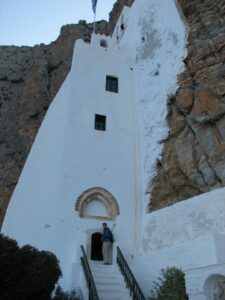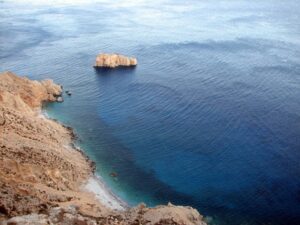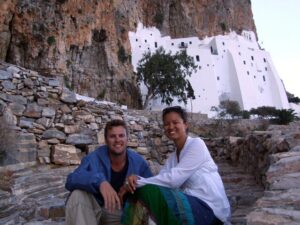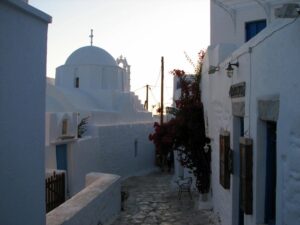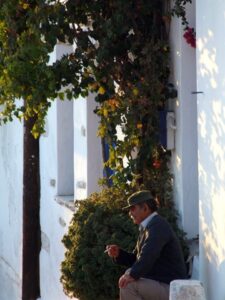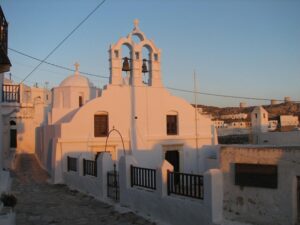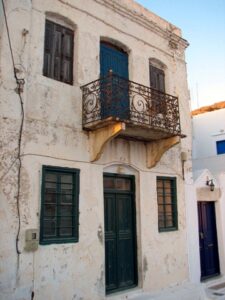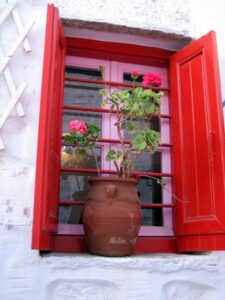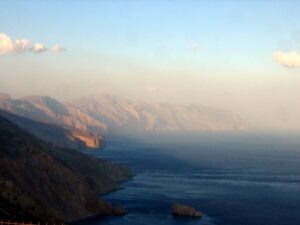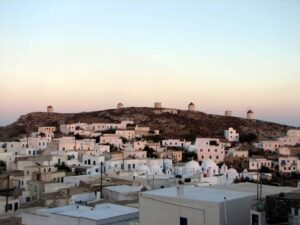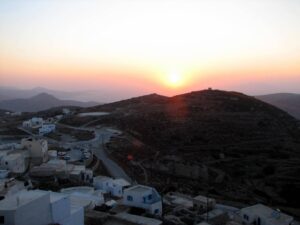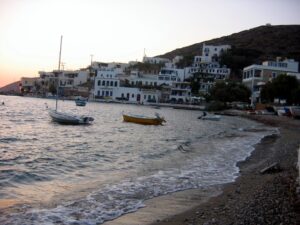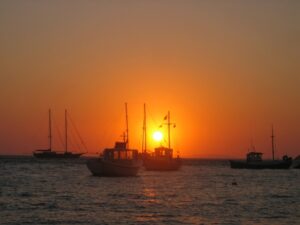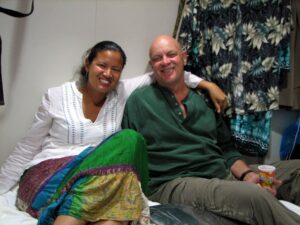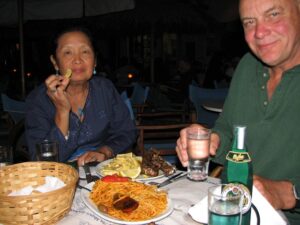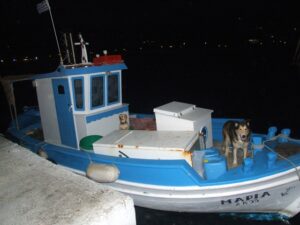Amorgos, the easternmost island of the Greek Cyclades island group, is famous for its gorgeous beaches and its incredible blue, pure endless waters. Because of its infinite beauty, it was chosen by Luc Besson as scenery for the principle scenes of his movie, The Big Blue. Swimming in its deep blue waters is a unique experience for the lucky visitors. Amorgos is distinguished for its archaeological wealth, popular architectural art, and local customs. The local residents occupy themselves with agriculture and animal farming as well as with fishing, which is plentiful since in this region of the Aegean Sea, the fish is abundant. Not to be missed is the monastery of Panagia of Hozoviotissa located at the northeast of the capital of Chora. It was founded by the Byzantine Emperor Alexios Komninos in 1088 and it is considered a most important site.
16 Sep: Lovely Amorgos appeared to have a lot to offer, and we were excited about the prospect of renting scooters to explore the island. Our basic plan was to head up north towards Aegiali and visit Tholaria and Langada (picturesque villages located in the hills above the port), head back towards the Chora and hike down to the 11th century Moni Hozoviotissis, return back up to the Chora and walk its maze like streets, and return back to Katapola in time for dinner. Hopefully we would have enough time for such an aggressive agenda!
At 1130 am, we pulled into Katapola harbor, and were able to disembark the cruise fifteen minutes later. As we were walking past a waterfront café, a strong gust of wind suddenly blew several table umbrella stands away, as well as overturned a heavy potted plant. This set the locals off scrambling to prevent further damage. As we were soon to find out, it was a prelude of things to come. The Greek meltemi (heavy fall winds) had finally caught up to us! We ended up finding Thomas Auto-Moto rental at the far end of the harbor, and rented two scooters for 13 Euros/day each (including full comprehensive insurance which was highly recommended, or 10 Euros without). Thomas accepted Euros cash or coins only, and after paying up, we headed uphill towards the Chora. The wind was blowing briskly, and we were amazed at how powerful it felt. It was a bit scary riding on the back of a scooter with strong gusts of wind blowing full force at random intervals…but it was also really invigorating. Thankfully, all of us had the foresight to wear sunglasses today, as we desperately needed them to keep the windswept debris out of our eyes. Goggles would have been better, but at least the sunglasses provided us with some protection.
We stopped by the first gas station we saw on our way up to Chora to refuel, and amazingly this venture only cost us 6 Euros for both scooters. At the Chora roundabout, we followed the signs towards Aegiali (Egiali) and enjoyed the curvy roads and the phenomenal view. Mountain goats were feeding everywhere, and wow, were these goats nimble! As they saw us approaching, some of the goats would start leaping from one rocky crevice to another. We couldn’t tell if all of the goats were domesticated or not, but many of them did have copper bells strung around their necks. As they ran across and down the road, we would hear them clinking and clanging away, causing quite a noisy commotion.
The views on our drive were absolutely mesmerizing, and we could easily see why Amorgos was chosen as the set for the movie “The Big Blue”…the pristine waters off the coast looked incredibly inviting, with gorgeous hues of blue and turquoise. In fact, if the wind hadn’t been blowing as hard, we would definitely have made a beach day of it. But instead, we were content to sightsee.
The first village we pulled up into was Tholaria, which had an impressive cathedral to greet us. Dario had taken an incredibly picturesque photo in this village with several donkeys and their traditional saddles. He explained that many villagers still used donkeys as their primary means of transport, and we were quite keen on seeing this for ourselves.
We wandered through town until we came to an old stonehouse – cum – bar which had been lovingly restored named “Pakezo”. The old wooden beams and stonework made for a rustic, charming look, and we decided to stop here for several shots of raki (a regional drink of the island of Amorgos that is made from raki and sugar). The plain raki shots were quite strong, but the sweetened raki was delicious and savory. We didn’t want to stagger out of there (as we still had a lot of sightseeing to do!), so we bid farewell to the ever friendly owner and his girlfriend and continued our explorations of Tholaria.
After meandering through the entire village, we hopped back on our scooters and headed for Aegiali’s beach where we decided to take a break for lunch. We scoped out two benches beneath a shady tree and set up our picnic of red wine, tsatsiki, fresh tomatoes and cucumbers, sausages, cheese and combined it all to make a tasty meal.
The neighborhood kittens came running when they smelt food. We have to say that Greece’s cats and kittens are undeniably the most friendly and persuasive of any we’ve ever seen! We fed them leftovers from lunch and made fast friends for life. After chasing them off from underneath our scooters, we headed off towards Lagada, which is another gorgeous village perched in the hills above Aegiali.
Once in Lagada, Becky befriended some locals who kept trying to persuade her to ride their donkey (in a skirt no less!). After a bit of convincing, she hopped up and the villagers laughed at her riding style (she just hopped into the saddle and sat astride the mount). One of the villagers showed her how the locals ride donkeys, and he hopped up and side straddled the donkey, gave it a swift kick in its hind legs, and off they went. Very cool experience and everyone got a big kick out of their donkey rides. Bidding farewell to our newfound friends, we wandered around Lagada and admired its twin domed church before hopping back on our scooters for the drive back to Chora.
After parking our mopeds in one of Hora’s parking lots, we were afraid the blustery winds would knock them down. The winds were blowing something fierce…and we decided to walk into the Hora’s labyrinth streets in a vain attempt to escape from the strong gusts of wind. Bob and Ann decided to stay in beautiful Hora to admire its white houses and maze-like streets and relax a bit, while we were keen on completing our pilgrimage to the Monastery of Hozoviotissa. Little did we realize at the time, but this would require us walking uphill both ways! Yeah, yeah…we all remember the jokes our parents used to tell about how they used to have to walk barefoot in the snow, uphill both ways to get to school…but in this case, we really did experience the unique art of getting our butts kicked twice during our afternoon hike.
Our LP guidebook has this to say about Hozoviotissa Monastery, “a visit to the 11th century monastery is unforgettable, as much for the spectacular scenery as for the monastery itself. The dazzling white building clings precariously to a cliff-face above the east coast. A few monks still live there and tours are sporadic, but worthwhile and free…a great round trip is to catch the bus from Katapola to Hora, stroll the length of Hora’s main street and on to an upper car park below a radio tower. Go down to the right of the car park viewpoint, through a gate and then follow a zigzag track with exhilarating views to reach the road. Turn left here to reach a junction, the left branch of which leads in 500m to the monastery.”
After we read that, we figured it was a fairly easy, straightforward and short hike…but once we followed these directions, we realized that the hike was not that short! It took us at least 20 minutes to get from the town of Hora to the road (all downhill on the zigzag path), and another 20 minutes to get from the road to the entrance of the monastery (all uphill).
The trademark of Amorgos did not disappoint, and we were glad we made the effort to visit. The monastery is built right into the cliff-face and appears to be an apparition out of the rocks, plus it has an incredible view out to the sea. The friendly monk met us with greetings of “Kaleespera” (“good evening” in Greek) and guided us up into the interior of the church (where donations are accepted and candles can be obtained), and after we had tired of the amazing vistas on the monastery’s balcony, we headed back in and the monk led us into a waiting area where rakomelo (a sweet Amorgos beverage made from raki, cinnamon, cardamom, regional herbs and honey) and water were served. How cool was that…getting served alcohol from a monk inside an incredible monastery?
We still had a hike back uphill to return to Chora, so we departed the monastery reluctantly and made it back 40 sweaty minutes later in time for sunset. Wandering around Chora’s streets are a delight, as they are very quaint, clean, and confusing…leading us to walk in circles until we realized “hmmm, that building looks awful familiar” and were able to orient ourselves after a period of trial and error.
The meltemi winds didn’t die down with the sunset, so we snuggled on the scooter together and inched our way from Chora to Katapola, against some fierce wind resistance. More than once, we thought our moped would literally be swept off the roads from the gales of wind, but somehow we managed to arrive to Katapola unscathed, reuniting with Bob and Ann who had long given up on us up at Chora. We returned our rentals, and headed back to EasyCruise to freshen up and grab a couple pre-dinner drinks, before heading back out into Katapola for dinner.
Mouragio (Mourayio) restaurant by the ferry quay did not disappoint, and our fishermen spaghetti and roasted lamb was sumptuous. We ate heartily tonight, as it was surprisingly cold out (the winds were still a-blowing) and we were all ravenous. Two big thumbs up for Amorgos, which we voted as one of our favorite Greek islands!
